英语口译基础教程UnitIntroduction
- 格式:ppt
- 大小:730.51 KB
- 文档页数:32
![interpretation Lesson[1]精品PPT课件](https://uimg.taocdn.com/67d4687e10a6f524ccbf85a1.webp)

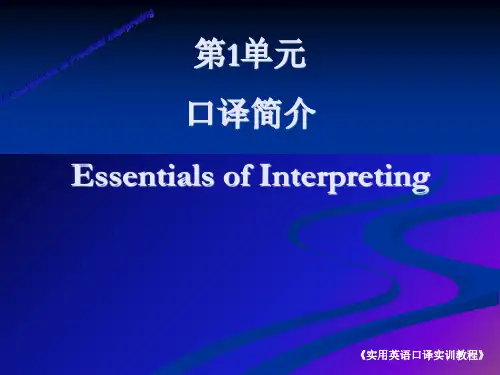
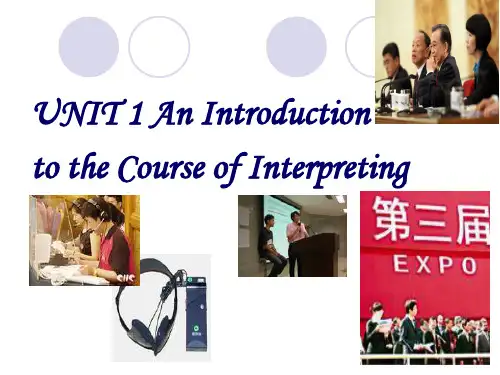
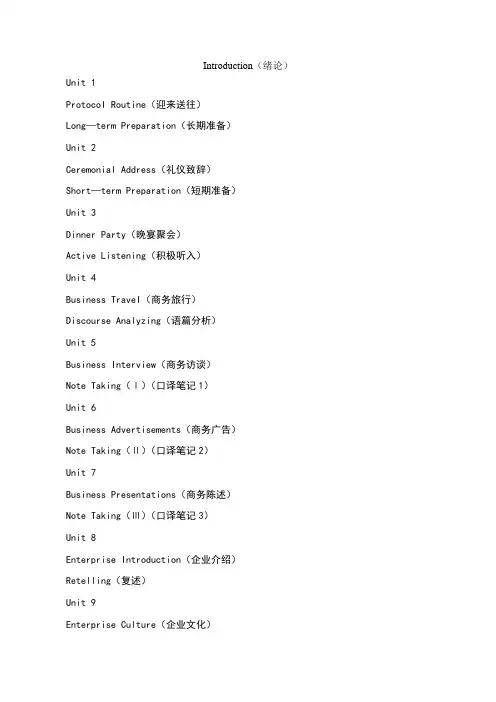
Introduction(绪论)Unit 1ProtocoI Routine(迎来送往)Long—term Preparation(长期准备)Unit 2Ceremonial Address(礼仪致辞)Short—term Preparation(短期准备)Unit 3Dinner Party(晚宴聚会)Active Listening(积极听入)Unit 4Business TraveI(商务旅行)Discourse Analyzing(语篇分析)Unit 5Business Interview(商务访谈)Note Taking(Ⅰ)(口译笔记1)Unit 6Business Advertisements(商务广告)Note Taking(Ⅱ)(口译笔记2)Unit 7Business Presentations(商务陈述)Note Taking(Ⅲ)(口译笔记3)Unit 8Enterprise Introduction(企业介绍)Retelling(复述)Unit 9Enterprise Culture(企业文化)Public Speaking(公开演讲)Unit 10Marketing & Promotion(市场营销)Paraphrasing(一句多译)Unit 11Business Negotiation(商务谈判)Figures Interpreting (数字口译)Unit 12Business Meeting(商务会议)Idioms Interpreting(成语口译)Unit 13Investment&Profits(投资利润)Fuzzy Interpretation(Ⅰ)(模糊表达1)Unit 14Business Policy(商务政策)Fuzzy Interpretation(Ⅱ)(模糊表达2)Unit 15International Exhibition(国际会展)Fuzzy Interpretation(Ⅲ)(模糊表达3)Unit 16Public Relations(公共关系)Sight interpreting《视译练习)Unit 17Business Strategy(商务策略)Shadowing(影子跟读)Unit 18Transportation & Logistics(交通物流)Quality Assessment (质量评估)U n i t F o u rB u s i n e s s T r a v e lUnit Objectives (单元目标)After reading this unit, you shouldunderstand the ways to identify the main ideas of the source text.find ways to improve your interpreting skills and performance.master the basic words and expressions about business travel.know some cultural background knowledge about business travel.reparingI. Interpreting Skills (口译技能)Read the following presentation about discourse analysis and try tounderstand the four speech types and know how to identify the main ideasof the source text. Then complete the following task:1. Listen to the passage, “My first day in New York”, and answer thefollowing questions:1). When did the author first arrive in the US2). What did the author do on the way to his hotel3). Where did the author get something to eat after his friend had left4). Why couldn’t he have what he really wanted at the restaurant5). What did the author do after dinner2. Listen to the passage again and try to catch more details, and thenretell the story in your own words.Decoding Training (II): Discourse Analysis(语篇分析)Interpreting is to “understand and make understood”. To interpret the speech, one must first understand the message of the speech. However, comprehension(理解)of the source discourse goes beyond the simple recognition of words and linguistic structures. The interpreter shall make an analysis of the source discourse. More importantly, the interpreter shall identify(识别)the speech type and know how to identify the main ideas of the original speeches.Identification of the Speech TypesSpeeches are diversified serving different occasions and purposes. It will be of great help to the interpreters if they know the speaker’s style. In most cases, speechesare prepared beforehand. Therefore, a study of the different types of writing helps an interpreter identify the main idea of a given speech. Following are the basic types of writing.1. Descriptive WritingDescriptive(描述性的)writing involves a great deal of detailed information. A descriptive discussion aimed at providing details of an event, a scene, a procedure, or a situation.This speech type demands a thorough background investigation of the speaker and the relevant situation by the interpreter.2. Narrative WritingNarrative(叙述性的)writing focuses on the development of events. There is no doubt that the interpreter should be very sensitive to dates, time phrases, and verb tenses when a narrative speech is dealt with.3. Expositive WritingExpositive(说明性的)writing deals with its subject matter in such orders as chronological, spatial, comparison, and definition. It would be to the advantage of the interpreter to conduct a background investigation of the speaker and the situation, for that would provide the interpreter with not only the necessary glossary but also the speaker’s standpoint(立场).4. Persuasive WritingPersuasive(劝说性的)writers always want to make their arguments clear, strong and convincing. When the purpose is to convince, writers of persuasive writing mainly employ two techniques -- induction(归纳)and deduction(推论). Inductive writing starts with specific examples or points to draw a general conclusion, while deductive writing illustrates its thesis at first and then supports and reinforces the thesis through specific examples or subordinate ideas.Identification of the Main IdeasIn the context of interpreting, the main ideas of the source speech can be identified at the sentence level and at the discourse level. Priority should always be attached to identifying the main idea at the sentence level. We argue that identification of main ideas be done on the basis of sentences. Training in identifying the main ideas in interpreting should naturally take place first at the sentence level.1. Sentence LevelThe most important task for an interpreter to identify the main ideas at the sentence level is to discern (洞悉) the subject, verb and object (SVO). It is highly significant for the interpreter to catch the SVO of the sentence while listening to the source text, as the SVO usually carries the major information of the sentence. For example, when listening to “The best way to carry money while traveling is to have a major credit card”, the interpreter is expected to catch “The best way is to have a credit card.”If the interpreter is able to catch the SVO of the sentence, he then will produce a complete sentence with the major information in the target language.2. Discourse LevelThere are also some skills an interpreter might employ on different occasions for grasping the gist(要点)of a speech at the discourse level. In a well-organized speech, the speaker usually explains his point in the first few sentences. Therefore, one of the ways to get the main idea of a speech is to attach priority to the beginning of the speech. Secondly, if the interpreter encounters a speech that is inductively constructed, the interpreter should, to the best of their ability, conduct a study of the speaker's background and viewpoints so that they can follow the speaker's logical guidelines.II. Phrase Interpreting (短语口译)Work on the following words and phrases. Interpret them into Chinese andEnglish respectively.A. English to Chinese1. Have a population of…2. Cover an area of…3. Date back to…4. Have a history of…5. Be situated in…6. The gross domestic product7. Dive-in restaurant 8. Quarantine certificate9. Duration of stay 10. Residence permitB. Chinese to English1、日程安排2、旅行路线3、起飞时间4、机场大楼5、候机室6、贵宾室7、问讯处 8、安全检查9、免税店 10、个人物品III. Sentence Interpreting (句子口译)Work on the following sentences. Interpret them into Chinese and Englishrespectively.A. English to Chinese1. I believe you're going out of your way for us.2. Wouldn't you like to spend an extra day or two here3. I'm afraid that won't be possible, much as we'd like to.4. I wonder if it is possible to arrange shopping for us.5. I will keep you posted.B. Chinese to English1. 我特地为你们安排,使你们在北京的逗留愉快。

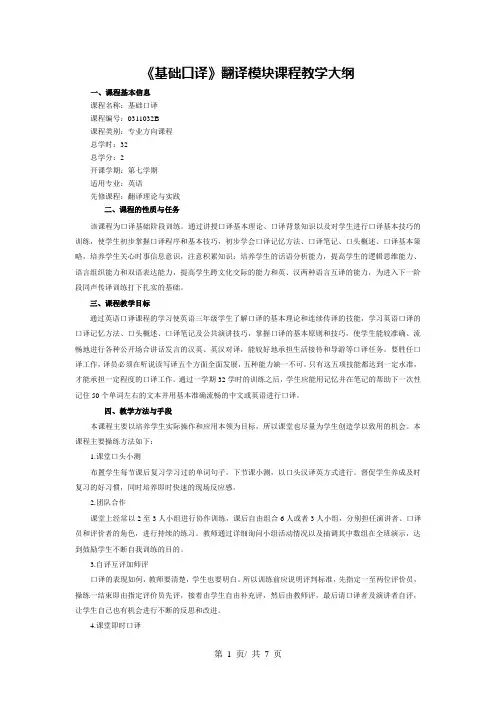
《基础口译》翻译模块课程教学大纲一、课程基本信息课程名称:基础口译课程编号:0311032B课程类别:专业方向课程总学时:32总学分:2开课学期:第七学期适用专业:英语先修课程:翻译理论与实践二、课程的性质与任务该课程为口译基础阶段训练。
通过讲授口译基本理论、口译背景知识以及对学生进行口译基本技巧的训练,使学生初步掌握口译程序和基本技巧,初步学会口译记忆方法、口译笔记、口头概述、口译基本策略,培养学生关心时事信息意识,注意积累知识;培养学生的话语分析能力,提高学生的逻辑思维能力、语言组织能力和双语表达能力,提高学生跨文化交际的能力和英、汉两种语言互译的能力,为进入下一阶段同声传译训练打下扎实的基础。
三、课程教学目标通过英语口译课程的学习使英语三年级学生了解口译的基本理论和连续传译的技能,学习英语口译的口译记忆方法、口头概述、口译笔记及公共演讲技巧,掌握口译的基本原则和技巧,使学生能较准确、流畅地进行各种公开场合讲话发言的汉英、英汉对译,能较好地承担生活接待和导游等口译任务。
要胜任口译工作,译员必须在听说读写译五个方面全面发展,五种能力缺一不可。
只有这五项技能都达到一定水准,才能承担一定程度的口译工作。
通过一学期32学时的训练之后,学生应能用记忆并在笔记的帮助下一次性记住50个单词左右的文本并用基本准确流畅的中文或英语进行口译。
四、教学方法与手段本课程主要以培养学生实际操作和应用本领为目标,所以课堂也尽量为学生创造学以致用的机会。
本课程主要操练方法如下:1.课堂口头小测布置学生每节课后复习学习过的单词句子,下节课小测,以口头汉译英方式进行。
督促学生养成及时复习的好习惯,同时培养即时快速的现场反应感。
2.团队合作课堂上经常以2至3人小组进行协作训练,课后自由组合6人或者3人小组,分别担任演讲者、口译员和评价者的角色,进行持续的练习。
教师通过详细询问小组活动情况以及抽调其中数组在全班演示,达到鼓励学生不断自我训练的目的。
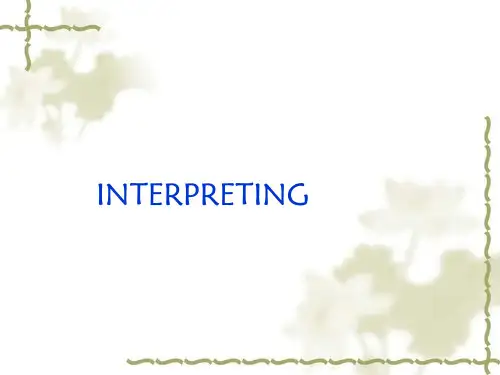

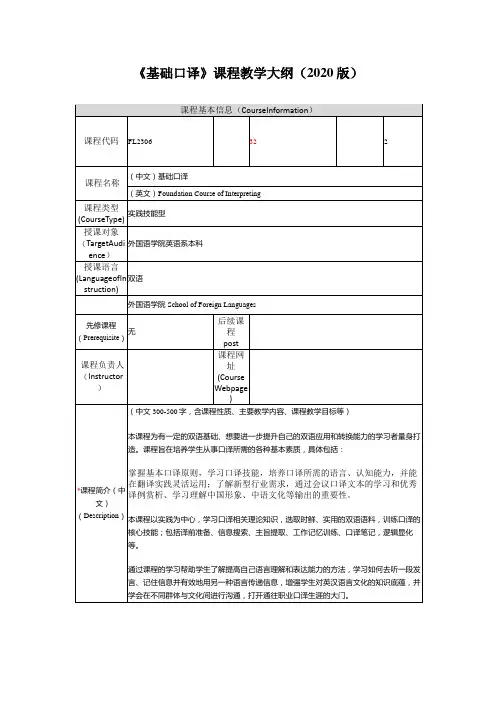
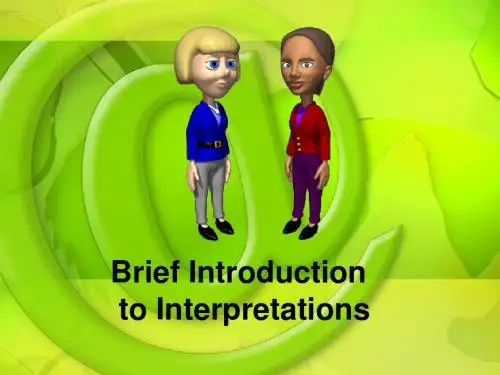
UNIT ONE COMPANY INTRODUCTIONPart One Sample DialoguesONEA: What line of business are you in?你们是从事什么行业的?B: We’re one of the leading household electric and electronic appliance manufacturers in China and we also do real estate, pharmacy, advertising, logistics, telecommunications, etc.我公司是中国主要的家用电器,电子生产商之一,另外我们也做房地产,药品,广告,物流,电信等。
A: Then what are your main products?你们的主要产品是什么?B: We produce a wide variety of household electric and electronic appliances, such as refrigerators, freezers, washing machines, air-conditioners, TV sets, microwave ovens, mobile phones, computers and so on.我公司生产各种家用电器,电子产品,像冰箱,冷柜,洗衣机,空调,电视机,微波炉,手机,电脑等等。
A: How about their sales position?他们销售情况如何?B: Well, their sales position varies from product to product. But each year we sell 10 million sets of all of them combined in the domestic market only and our products have been exported to more than 160 countries and regions in the world. Our sales volume last year totaled RMB 40 billion. In China we now have a 30% market share.销量随产品不同而不同。